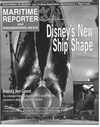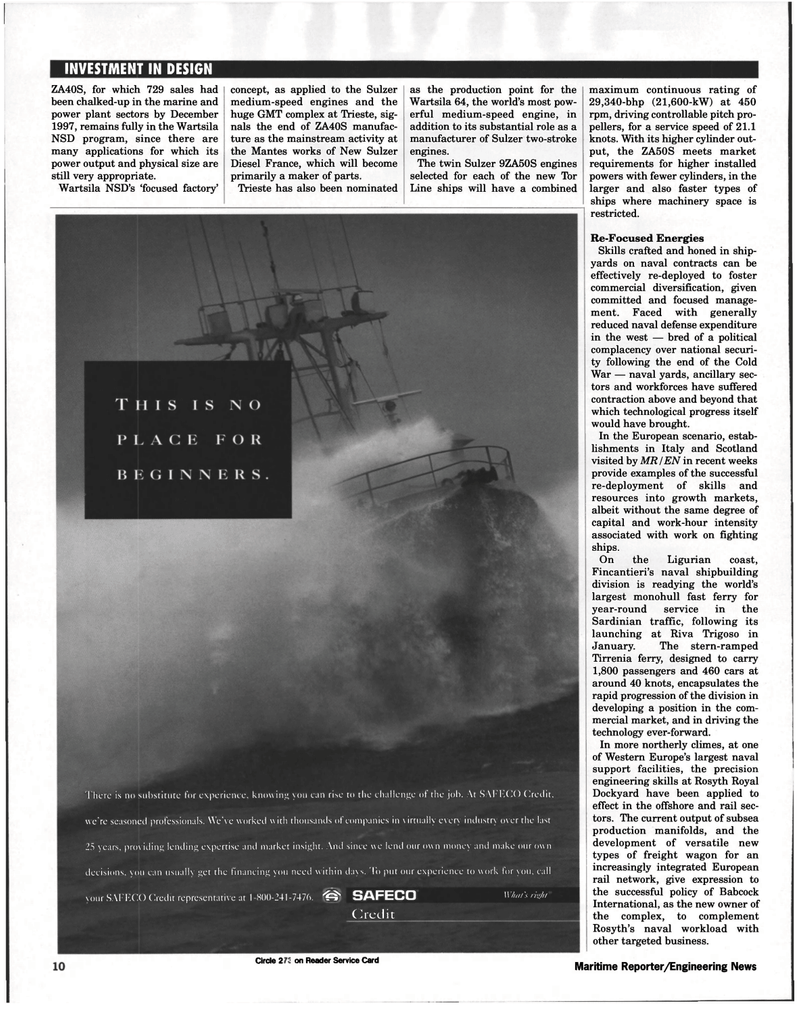
Page 10: of Maritime Reporter Magazine (March 1998)
Read this page in Pdf, Flash or Html5 edition of March 1998 Maritime Reporter Magazine
INVESTMENT IN DESIGN
ZA40S, for which 729 sales had been chalked-up in the marine and power plant sectors by December 1997, remains fully in the Wartsila
NSD program, since there are many applications for which its power output and physical size are still very appropriate.
Wartsila NSD's 'focused factory' concept, as applied to the Sulzer medium-speed engines and the huge GMT complex at Trieste, sig- nals the end of ZA40S manufac- ture as the mainstream activity at the Mantes works of New Sulzer
Diesel France, which will become primarily a maker of parts.
Trieste has also been nominated as the production point for the
Wartsila 64, the world's most pow- erful medium-speed engine, in addition to its substantial role as a manufacturer of Sulzer two-stroke engines.
The twin Sulzer 9ZA50S engines selected for each of the new Tor
Line ships will have a combined maximum continuous rating of 29,340-bhp (21,600-kW) at 450 rpm, driving controllable pitch pro- pellers, for a service speed of 21.1 knots. With its higher cylinder out- put, the ZA50S meets market requirements for higher installed powers with fewer cylinders, in the larger and also faster types of ships where machinery space is restricted.
Re-Focused Energies
Skills crafted and honed in ship- yards on naval contracts can be effectively re-deployed to foster commercial diversification, given committed and focused manage- ment. Faced with generally reduced naval defense expenditure in the west — bred of a political complacency over national securi- ty following the end of the Cold
War — naval yards, ancillary sec- tors and workforces have suffered contraction above and beyond that which technological progress itself would have brought.
In the European scenario, estab- lishments in Italy and Scotland visited by MR /EN in recent weeks provide examples of the successful re-deployment of skills and resources into growth markets, albeit without the same degree of capital and work-hour intensity associated with work on fighting ships.
On the Ligurian coast,
Fincantieri's naval shipbuilding division is readying the world's largest monohull fast ferry for year-round service in the
Sardinian traffic, following its launching at Riva Trigoso in
January. The stern-ramped
Tirrenia ferry, designed to carry 1,800 passengers and 460 cars at around 40 knots, encapsulates the rapid progression of the division in developing a position in the com- mercial market, and in driving the technology ever-forward.
In more northerly climes, at one of Western Europe's largest naval support facilities, the precision engineering skills at Rosyth Royal
Dockyard have been applied to effect in the offshore and rail sec- tors. The current output of subsea production manifolds, and the development of versatile new types of freight wagon for an increasingly integrated European rail network, give expression to the successful policy of Babcock
International, as the new owner of the complex, to complement
Rosyth's naval workload with other targeted business.
There is no substitute for experience, knowing you can rise to the challenge of the job. At SAFKCO Credit, we're seasoned professionals. We've worked with thousands of companies in v irtually every industry over the last 25 years, providing lending expertise and market insight. And since we lend our ow n money and make our ow n decisions, you can usually get the financing you need within days. To put our experience to work for you, call your SAFECO (: red it representative at 1 -800-241-7476. SAFECO
Credit
W/iti/'s riufit 26 Circle 286 on Reader Service Card Maritime Reporter/Engineering News

 9
9

 11
11
